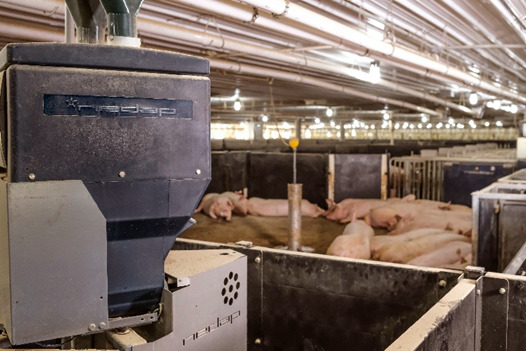Planning for the future of sow barns
Are your sow facilities ready to help you successfully meet a changing industry?
Rising feed and other input costs – and larger industry factors – underscore the need to develop long-term strategies to ensure future profitability.
For instance, in 2021:
– Farrow-to-finish production costs are up at least 30% for many producers relative to last summer.[1]
– Construction costs are up roughly 15% across the board, and materials and labor are in short supply.[2]
– Policy changes ahead will dictate housing and husbandry practices across U.S. state lines.
“Current market prices offset increasing input costs, at least here in the United States, but now is the time to plan for long-term smart solutions,” says Holly Hutchinson, Nedap Livestock Management sales executive. “We can’t predict how long broader inflation pressure, higher incomes and consumer preferences will help maintain the current market.”
Here are four ways Nedap’s Electronic Sow Feeding technology can help you address input costs and prepare for a changing future:
1.Increase efficiency
“Nedap Electronic Sow Feeding offers more efficient animal management,” says Hutchinson. “These solutions connect pigs to daily individual management. You can collect real-time data about feed consumption and activity for large groups or individual animals. Then, you can use these data points to drive whole-herd performance improvement.”
You can use the data to make better management decisions for things like maintaining body condition or providing extra attention to sows that require management interventions versus having to physically monitor each pen. Management is based on real-time, accurate information, not averages.
2.Lower feed waste
Feed accounts for more than half of all pork production costs. Automated feeding can help you easily meet the increased nutritional needs of a sow by controlling the frequency and volume of feed thanks to accurate data.
Since feed is a large percentage of input costs, it’s good to review your feed management practices often. Evaluating data will show you ways to maximize your return on investment.
The payoff is significant. “Farms have reduced feed waste in sow barns up to 20% simply because they are not overfeeding animals,” says Hutchinson.
3.Boost labor effectiveness
Automated systems do not eliminate labor needs, but they do allow you to schedule and direct employees more efficiently. Farmers using automated systems say the technology attracts savvy employees, and the systems allow people to focus on the animals that need extra attention, elevating animal care and job satisfaction.
Ready access to accurate, timely data to support quick decisions is one of the favorite features for many farmers and their teams. Animal management is much easier – it’s less stressful for pigs and people, and more accurate.

4.Meet industry challenges
Group housing of different pen sizes combined with electronic sow feeding is the future of the industry, whether you manage small, medium or large groups of animals. In the United States, pending policy changes like California’s Proposition 12, which is slated to take effect Jan. 1, 2022, are changing industry housing standards. This legislation outlines standards for breeding pigs, requiring each sow to have at least 24 square feet of usable floor space.
In many current sow facilities, this will result in a loss of 20% productivity. It’s estimated Proposition 12 will cost U.S. farms an estimated €1367.58 to €2136.84 ($1,600 to $2,500) per sow to convert facilities to comply.[3]
Nedap Electronic Sow Feeding technology can help you get an optimal return on your facility upgrade investment by focusing on feed, labor and animal efficiency to better manage input costs.
Are you ready for the future?
“Ultimately, animal management technology can give you the actionable data needed to continuously improve individual pig care and animal performance, handle costs and take advantage of the input savings the system brings to the farm,” concludes Hutchinson.
Contact the Nedap team to learn more about how Nedap Electronic Sow Feeding technology can help elevate productivity and profitability on your farm.
[1] Shike J. June 8, 2021. “Economists Call Out Game Changers in the Pork Outlook.” PORK. Available at: https://www.porkbusiness.com/news/industry/economists-call-out-game-changers-pork-outlook.
[2] Kerns J. July 19, 2021. “Back to reality, sans the waterslides.” National Hog Farmer. Available at: https://www.nationalhogfarmer.com/news/back-reality-sans-waterslides
[3] Fatka J. April 19. 2021. “California’s Prop 12 brings uncertainty to hog producers.” National Hog Farmer. Available at: https://www.nationalhogfarmer.com/farm-policy/californias-prop-12-brings-uncertainty-hog-producers